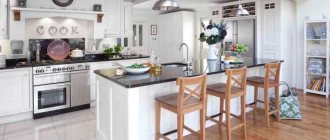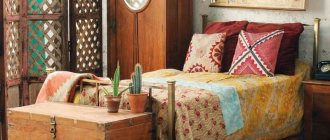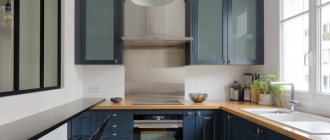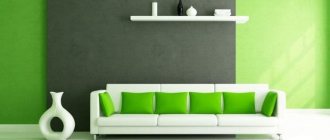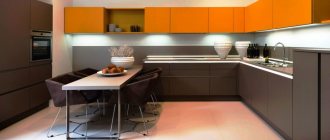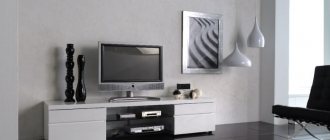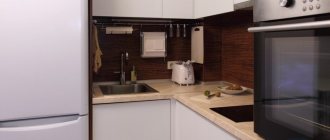The kitchen floor sets the stage for design and functionality. Consider your lifestyle and cost when choosing the right surface for you, as the kitchen is the center of your home, where you prepare family meals and gather together. Floors in this busy area must withstand heavy traffic, dropped dishes and spills. Start with these considerations.
Criteria for choosing flooring for the kitchen
In this room the temperature constantly fluctuates and culinary passions burn: after all, the food will not cook itself. Hence the loads that any material used in it must withstand.
The optimal flooring material for a kitchen will be one that has most of the following characteristics:
- low hygroscopicity - the floor material should not absorb moisture to avoid mold;
- anti-slip coefficient - the higher the better, because sometimes in the kitchen you have to deftly dodge from the stove to the refrigerator or dining table, and injuries are definitely not needed here;
- hygiene and environmental friendliness - where food is located, there is no place for harmful fumes, accumulation of dirt and soot;
- resistance to mechanical damage - it’s not always possible to hold everything in your hands, so the floor must more or less cope with dropped dishes;
- good thermal insulation or heat conduction properties - even in winter it should be comfortable to cook food or just drink coffee in the morning.
Designer refinements in floor design have also not been canceled: the most universal solutions are welcome, which can easily be adapted to modern interiors and create a cozy and homely atmosphere in the kitchen.
Combined floors
This is the name for options in which 2 or more materials are used at once on one floor area. Or one, but with different textures. This synthesis is most often due to the need for functional zoning of the kitchen.
With tiles
The best combinations with ceramic tiles on the kitchen floor are:
- laminate;
- porcelain stoneware;
- linoleum;
- parquet board.
The floor in the more demanding work area, where grease, moisture and other cooking artifacts enter, is finished with tiles, and the second half of the kitchen with a dining complex is decorated with laminate or linoleum.
Or, on the same floor area, tiles of identical shape are used, but in different shades. What is being pursued here is a decorative rather than a practical effect.
At the point where materials join on the kitchen floor, a strip of plastic or metal is most often used. It’s better to match it to the color of the floor - it’s more harmonious. Or, on the contrary, highlight it and make it contrasting.
You can also try a combination with a floorboard. Be prepared for some grueling pruning, but the results are worth it.
With laminate
In addition to the traditional partnership with tiles on the same area, laminate is also quite compatible with linoleum. True, you will have to tinker a lot with trimming and designing the joint on the kitchen floor between the two materials. It needs to be made as securely as possible so that moisture does not get inside and completely ruin your coating.
When choosing a combination with ceramics or linoleum, do not forget about the height of the floor. And if with tiles everything can be fixed with the right amount of glue, then, for example, with linoleum it is much more difficult.
Warm floor in the kitchen
Heated floors in the kitchen will allow you to comfortably walk around this room even in the cold season. This is especially true if you have ceramic tiles laid, the apartment is located on the first floor exactly above the basement, or the heating system operates at an average level. They install both electric and water heated floors.
Electric heated floors can be:
- cable - based on a two-core shielded cable, poured into a cement screed, ideal for tiles;
- film - based on a carbon film with copper and carbon fiber, very economical and loses less heat, optimal for installation under linoleum, laminate and parquet, and does not require screed;
- rod - infrared, is a mesh with intersecting carbon and copper elements, tile-like, universal and durable.
The installation of floor heating systems should be trusted to specialists in order to avoid subsequent operational issues. Be prepared to pay many times more for electricity. But this is quite a worthy exchange for comfort, isn’t it?
In private homes, water-heated floors are often used, which are cheaper in cost. It works by circulating water in a structure, the key elements of which are a collector and a thermostat. The base also needs to be well prepared: leveled, insulated, and provided with a vapor barrier. Only then can you begin installing the heating elements - in increments of 25-30 cm. After all the pipes have been laid, all that remains is to connect them to a common manifold. Using a thermostat, you can set the desired temperature - and in this simple way achieve the optimal level of heat all year round.
Auspicious colors according to Feng Shui
The color scheme should be filled with Yang energy, which is responsible for the harmony of a person’s internal forces. Inside such a room, fire and water constantly fight. They are symbolized by a sink with a stove. If you choose the color of the kitchen according to all the rules, then it can level out this conflict.
The most calming colors can be called all warm and light colors, which have a great effect on both the level of appetite and the energy and psychological level of a person. Such colors are light beige, white, cream, light green, etc.
If we talk about the element of fire, then there is a lot of it in the kitchen interior, thanks to the almost constantly switched on stove. If there is sufficient natural light in the kitchen, shades of red, orange and pink should be ignored, as they belong to the element of fire. This rule also applies to the element of water, because the sink is responsible for it.
For this reason, it is not recommended to use bright, cold colors. It is also worth considering that each zone is responsible for its own specific color and element, so you should not use the opposite shade to decorate the kitchen. Read what Feng Shui kitchen color you should choose using this link.
The most beautiful kitchen floors in photos
An interesting selection of spectacular floors, which we have divided into two parts. Whoever has a kitchen will be more interested in this scale.
In a small kitchen
In the kitchen-living room
Light kitchen colors
When can you choose a light kitchen design?
If, while looking at photographs of interiors, you have more than once caught yourself thinking that you are quickly scrolling through the dark options, while you linger on the light ones, you should decorate your kitchen in light colors. In addition, this solution is optimal for small rooms, since light colors will visually expand the space.
Light shades are suitable for anyone who cares about cleanliness in the kitchen - they create a feeling of freshness and cleanliness. Of course, you should not be afraid of the frequency of washing furniture facades.
Light colors in the interior are considered mandatory for high-tech, Provence, Tiffany and classic styles.



